All About Floors
Floor Finish Comparisons
The photos below attempt to illustrate the color differences of various floor finishes.
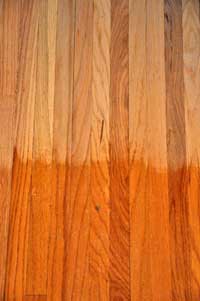 |
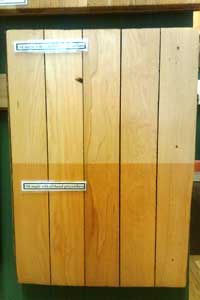 |
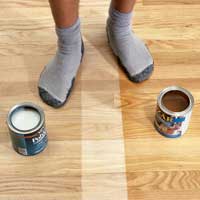 |
|
Old oak floor—a tinted sealer topped with water-based polyurethane on the top; old varnish on the bottom. |
Old maple flooring—water-based polyurethane on the top; oil-based polyurethane on the bottom. |
New oak floor—water-based polyurethane on the left; unfinished wood in the middle; oil-based polyurethane on the right. |
Floor Patching
Of the photos below, one illustrates how new maple flooring does not match old maple, and the four in a series illustrate the correct steps to patch a vent opening. All photos of floor patching courtesy of Tom Marzolf, Golden Rule Home Services. www.goldenrulehomeservices.com
The table below, “Hardwood Floor Grading Rules,” describes the difference between various qualities of available hardwood flooring. Print a pdf.
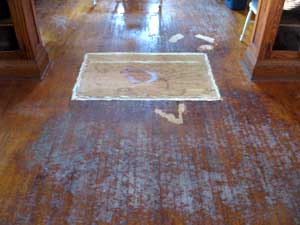 |
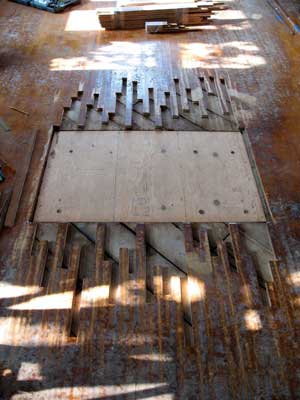 |
|
1. Previously hidden by carpeting, a vent area had been filled with plywood. |
2. After selectively removing boards to stagger the patch, the area is ready for installation of reclaimed maple flooring. |
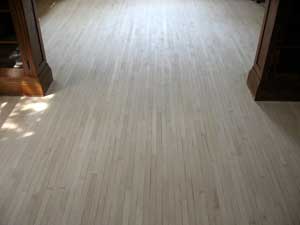 |
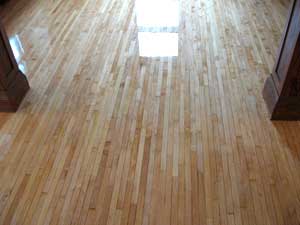 |
|
3. Patch completed and sanded. |
4. Patch finished. Difficult to tell difference between reclaimed maple and original maple floor.
|
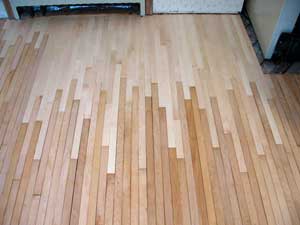 |
|
|
After one coat of finish, it is easy to see how new maple does not match the old. |
Hardwood Floor Grading Rules
|
Red or White Oak Grades |
Appearance Characteristics Allowed |
|
Clear |
3/8″ bright sapwood entire length of strip, small burls and fine pin worm holes and equivalent character such as small tight checks; in absence of these, one thin brown streak 3″ long to be allowed every 6′. Average board length: 3¾′ |
|
Select |
All above plus unlimited sound sapwood, slight imperfections in milling, reasonable amount of slightly open checks. Brown streaks should not extend the entire length of a piece. Small amounts of torn grain in face work are permitted. Average board length: 3¼′ |
|
#1 Common |
As above plus readily fillable checks and open knots under ½″ in diameter, flag worm holes, sticker stain, heavy streaks and prominent variations in coloration. Average board length: 2¾′ |
|
#2 Common |
Will admit any figure or natural variations of the forest product except shattered or rotten ends, large broken knots, excessive bad millwork or advanced rot. Average board length: 2¼′ |
|
Hard Maple Grades |
Appearance Characteristics Allowed |
|
#1 |
An occasional small, firm pin knot, not over 1/8″ in diameter, occasional green or black spots or streaks not over ¼″ wide and 3″ long, tight check not over ½″ long provided it is boxed within the piece, bird’s eyes and small burls and slightly torn grain which can be readily removed by ordinary floor sanding. Average board length: 3′ |
|
#2 |
All above plus distinct color variations, sticker stain, numerous green or black spots or streaks, provided they do not occur in combination with predominantly dark heartwood, slight checks not exceeding 3″ in length, dark spots or streaks with slight checks in center and small amounts of torn grain which cannot be removed by sanding. Average board length: 2¾′ |
|
#3 |
May contain all the defects common to maple except knot holes over 3/8″ diameter, unsound knots, voids on ends or edges, shake, heart checks or badly split ends. Average board length: 2¼′ |











